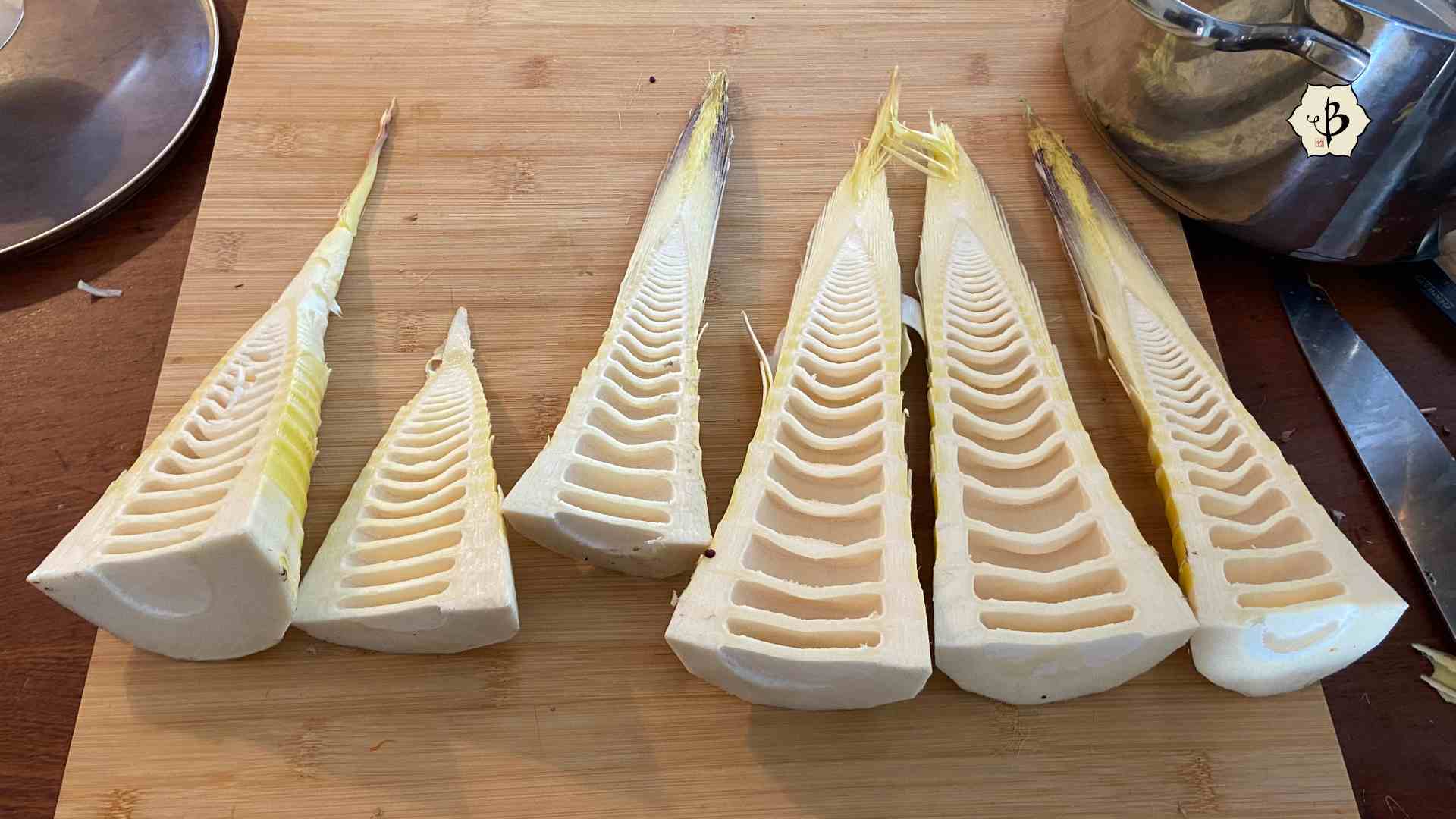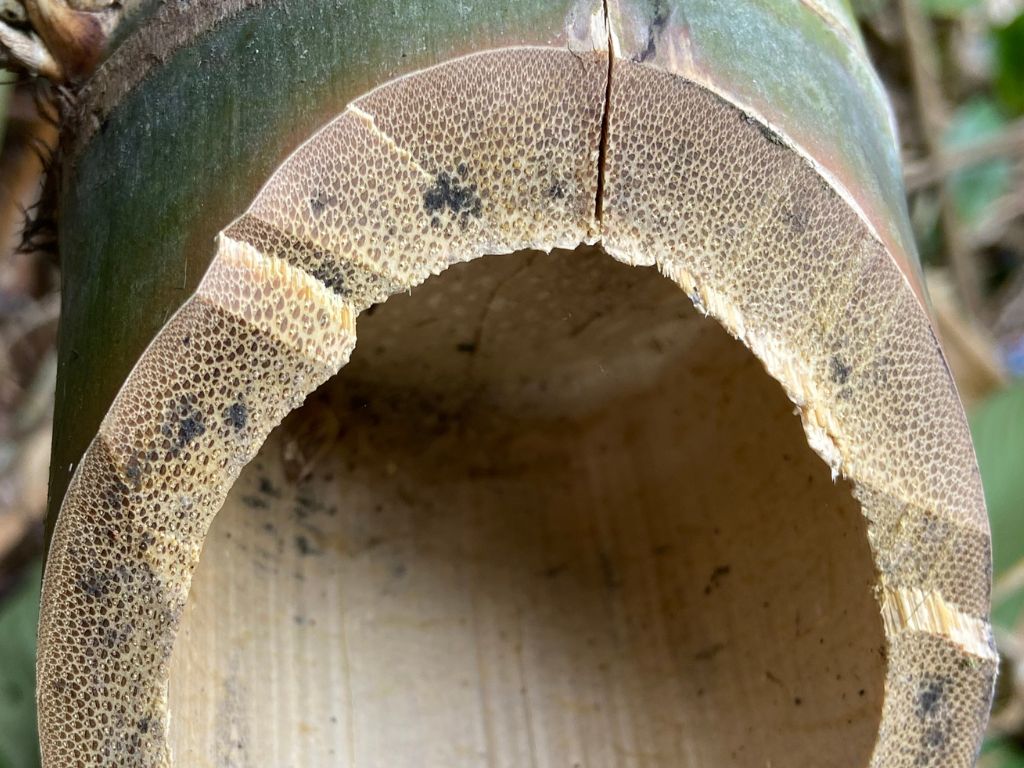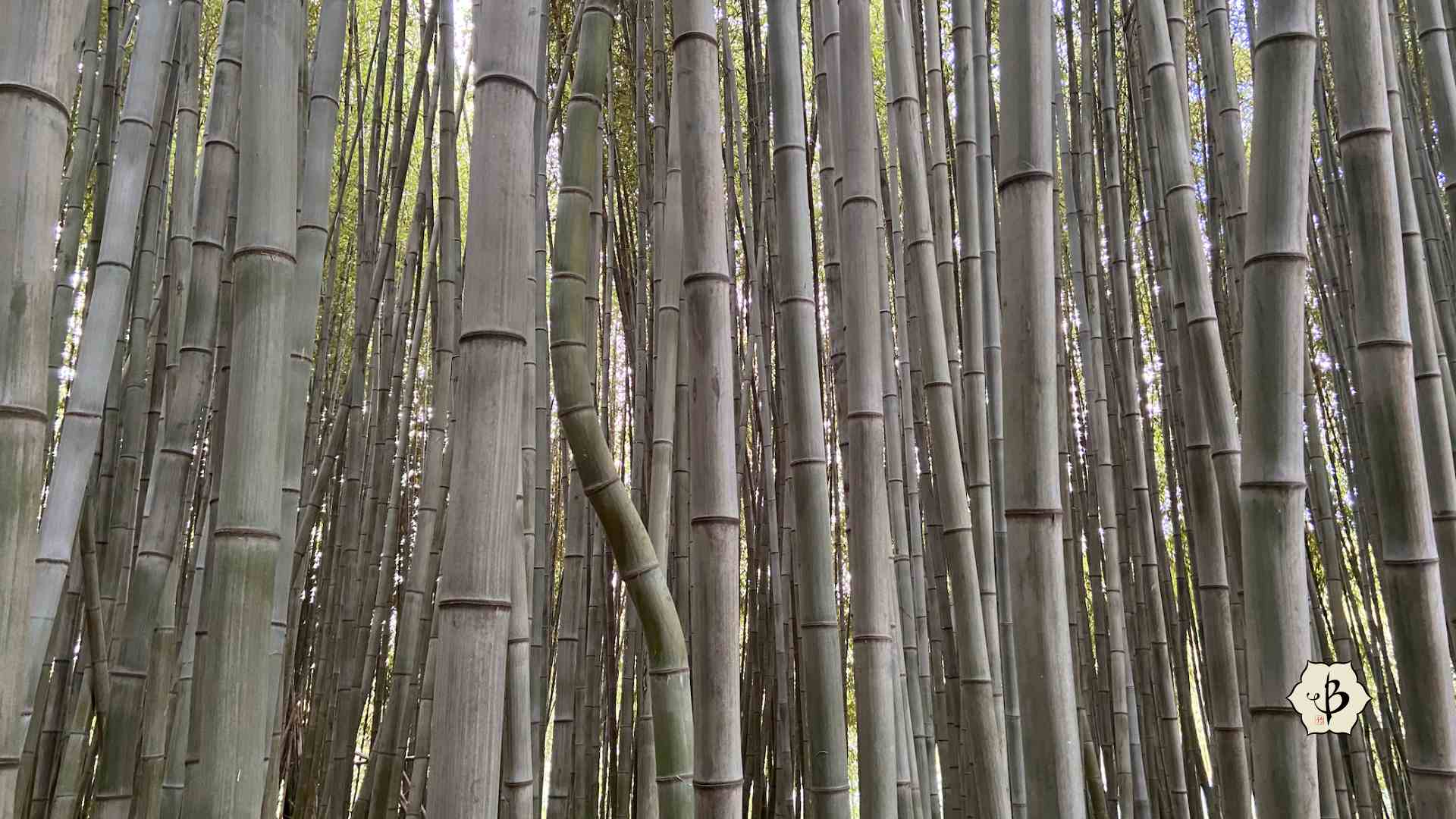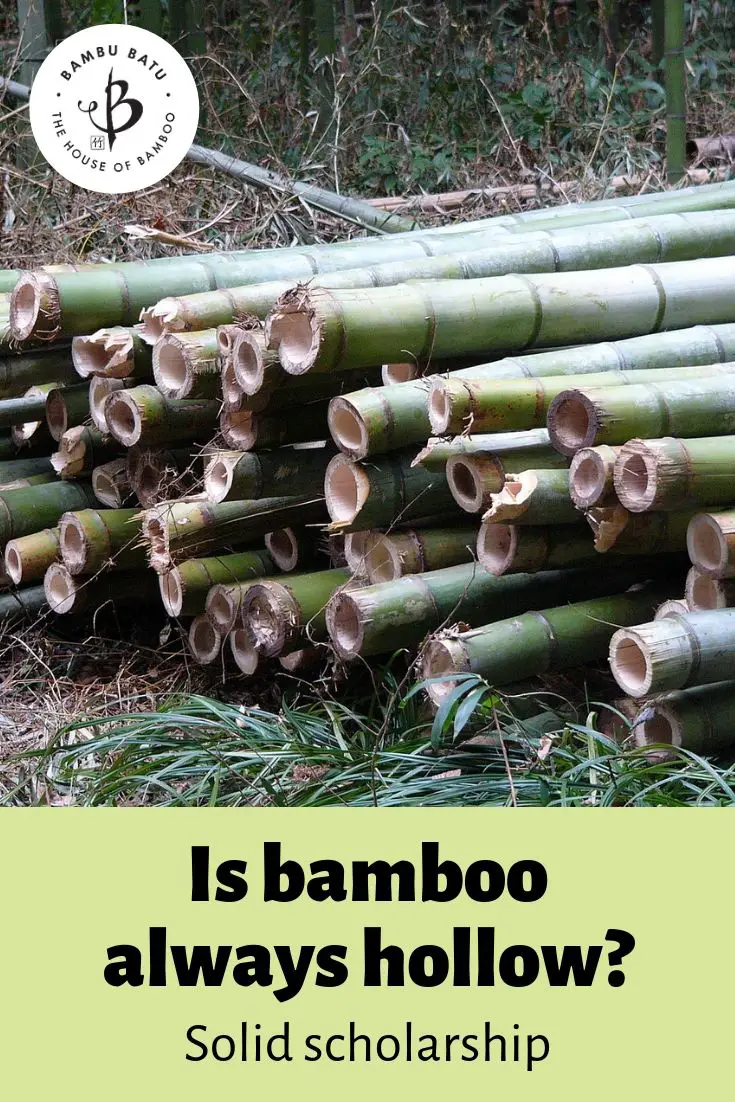Bamboo is like no other tree. Of course, that’s because bamboo is not a tree. Trees are solid, while grasses, including bamboo, are hollow. Trees grow larger in height and circumference every year, sometimes taking 50 years or more to reach full size. Individual bamboo stalks, or culms, reach their full height in a single growing season. So if you see a bamboo that’s 100 feet tall, then you know it grew that much in about three months. Amazing, but that’s how grasses grow.
Bamboo has the rare distinction of being hollow and woody at the same time. While trees have trunks and other plants have stems, bamboo has culms. Culms are a distinctive feature of all grasses, and they are almost always hollow. This unusual combination of features is what helps to make bamboo lightweight and flexible while still being very strong. Although the vast majority of bamboo species are hollow, there are a few varieties with solid stems or culms.
NOTE: This article first appeared in July 2019, most recently updated in May 2024.
Is every bamboo hollow?
Part of being a grass, belonging to the Poaceae family, means that bamboo has hollow culms. If you examine any kind of grass, from the corn in a field to the sod in your front yard, you will find hollow culms. If you’re studying a lawn, pay attention to the culms and the blades. The culm is the stem and the blade is the leaf.
One characteristic of bamboo, and grass in general, is the presence of nodes on the culms. We sometimes call these the joints. At these junctions, the bamboo is solid, resulting in separate, hollow sections. Therefore, even when bamboo is hollow —which it usually is — it is never completely hollow.

If you look at a fresh bamboo shoot, it might look to be solid. But if you cut in lengthwise, as in the image above, you’ll see that the hollow bubbles, or internodal cavities, have already formed. As the shoots extend upward, over the course of the growing season, those hollow sections will stretch out into long internodes.
Hollowness is the general rule with bamboo, but there are exceptions to the rule. Among the 1,500 kinds of bamboo in the world, the vast majority are hollow. A very small number are solid, and some bamboo canes just have thicker walls than others, so that they appear nearly solid.

Culm walls
When we talk about wall thickness, this is not the same as the culm diameter. The diameter describes the girth of the poles, measured on the outside. Bamboos can vary from less than a half-inch in diameter to more than a foot in diameter. (See Dendrocalamus sinicus.) But the wall thickness refers to how much woodiness there is between the inside and the outside of the ring. Usually, it’s just a centimeter or less, and the center is hollow.
All different varieties of bamboo have different wall thicknesses, and this is a very important quality to consider if you plan to use your bamboo for construction. Bamboo with thin walls will bend more easily, which might make for better fishing poles. On the other hand, thicker bamboo will be stronger, sturdier, and better for building substantial structures.
Phyllostachys vivax is a big timber bamboo whose poles can get 4 or 5 inches in diameter. But because they have thin walls, it’s not a particularly good species for construction. Phyllostachys nigra ‘Henon’ looks very similar, at least from the outside, very comparable in size, but the culm walls are much thicker. That makes Henon a far better choice for building.
Incidentally, tropical clumping bamboos are usually better for building because they are more resistant to cracking. But that has more to do with the density of the tissue than the thickness of the culm walls.

Advantages of being hollow
One might assume that the hollowness of bamboo would compromise its strength and structural integrity. Instead, it seems to have the opposite effect. The emptiness inside of bamboo allows the towering poles to bend more easily in the wind without breaking. It lends the bamboo its supple elegance and flexibility.
And when it comes time to harvest, a 60 or 80-foot bamboo pole will have a fraction of the weight of a similarly sized tree. That makes the bamboo easier to transport and work with. You will also find that bamboo is much easier to saw through, compared to solid wood.
These properties provide a great advantage, especially in regions with less access to heavy machinery and power tools. And that’s where a great preponderance of bamboo grows, in the developing world and near the equator.
On a metaphorical or spiritual level, bamboo’s hollowness is a trait worth emulating. Especially in Buddhism, they cherish the notions of humility and non-attachment. Bamboo, in all its wisdom, has learned to let go of what is unnecessary. Similarly, we should not cling to the things and ideas that will make us grow rigid. And we should never become too full of ourselves.
Bamboo at the node
Sometimes you’ll see a cross-section of bamboo that is solid. But in most cases, this is not from a bamboo that is completely solid. More likely, it was cut at the node where the bamboo is solid, at the thin partition we call the diaphragm. The spaces in between, the internodes, are probably still hollow. Also, if you cut the bamboo pole down at the very base, you’ll often find that the culm is solid there as well.

The nodes and internodes provide another feature that makes bamboo fun to work with. Cut a thick bamboo pole just below the node and several inches above the node, and you’ll have a simple yet attractive drinking cup. Keep in mind, though, that bamboo is not really waterproof, so it shouldn’t be used to make a vase for flowers. It’s perfect, however, for something like a pencil holder in the office or a utensil holder in the kitchen.
As a drinking cup, it will work for a while, but eventually, the water will soak in. Use it briefly and empty the cup when you’re finished. Don’t leave liquid in it overnight.
If you want to make a bamboo vase, the best method is to use a very thick-diameter bamboo culm and slip a narrow glass inside. The glass won’t be visible from the outside, but it will hold the water safely. Otherwise, the bamboo will gradually soak up the water, ultimately leaking and making a wet mess.

Solid bamboo varieties
One of the few varieties with a solid stalk is Phyllostachys heteroclada f. solida. Commonly known as simply “solid bamboo”, this is a subspecies of “water bamboo”, thriving in swampy areas and river beds of central Asia.
Bambusa nana is a medium-sized subtropical variety that’s been growing in popularity. An attractive ornamental, it grows about 30 feet high with culms up to around 2 inches in diameter. Solid poles give it great strength and make it useful for a range of crafts and building applications.
Dendrocalamus strictus, a timber bamboo native to Southeast Asia, also has the nickname of solid bamboo, and for the same reason. This could be somewhat confusing, except that these varieties have very different habitats and growth habits. Phyllostachys is a genus of temperate runners, and Dendrocalamus bamboos are tropical clumpers. In most cases, D. strictus has very thick walls, but is not completely solid. For this species, drier growing conditions tend to result in thicker walls, or bearly solid culms.
Dendrocalamus stocksii grows in northern India and has completely solid canes. This species is also interesting for the fact that its flowers never actually go to seed. It makes an excellent building material though and is a very economically important plant in India. Its edible shoots can also provide a plentiful food source.
In Central and South America, most members of the Genus Chusquea have solid stems. The most popular species for ornamental cultivation are probably C. gigantea and C. culeou, both native to Chile. Attractive culms and lush foliage make them nice to look at, and the solid poles are excellent for crafts and light construction. Another interesting species, C. quila tends to spread out and grow like a vine. They appear predominantly in Chile and Argentina.
Indocalamus latifolius ‘Solidus’: This unusual species not only has solid stems, but it also has exceedingly large leaves with prolific foliage. This makes it a great choice as a low privacy hedge. They usually grow 8 to 10 feet tall, or less in cooler climates. Thin, graceful culms are about .5 inches in diameter and turn a lovely deep, dark green with age. This running bamboo is also very cold tolerant, hardy to -5º F.
Phyllostachys viridiglaucescens: Another temperate running bamboo, “Green Glaucous Bamboo” has a very good quality of wood for crafts and structures. It can grow 10 to 25 feet tall, depending on the climate, with 2 to 3-inch thick poles, upright, mostly very straight, and very attractive. The leaves are vibrant green and the culms have very thick walls, almost solid at the base.

Further reading
To learn more about other bamboo varieties and growth habits, take a look at some of these interesting articles.
- 10 Best bamboo varieties for your garden
- 11 Cold hardy bamboos
- Best bamboo varieties for construction
- Moso Bamboo: King of grasses
FEATURE IMAGE: Hollow culms of giant Denrdrocalamus asper. Photo by Fred Hornaday.



























Is it possible to purchase a piece of solid bamboo for woodturning?
Hi Lenny, Unfortunately that’s not something we have available for sale. You might check with some bamboo nurseries and see if they have any solid stem bamboo available.
What are some of the thin walled hollow bamboo species? I want to make bamboo tube rice. Thanks for any info.
Usually running bamboo has thinner walls, like some medium-sized varieties of Phyllostachys. But in Southeast Asia they use Bambusa blumeana for tube rice because the inner wall of the this bamboo have a sweet lining.